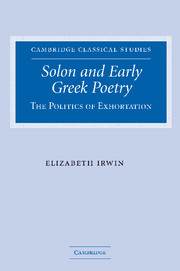Book contents
- Frontmatter
- Contents
- Acknowledgements
- List of abbreviations and editions
- Introduction
- PART I THE POLITICS OF EXHORTATION
- Introduction
- 1 Understanding the political in martial exhortation elegy
- 2 Synthesising content and context
- 3 Contextualising the city: archaic verse inscriptions and the ‘rise’ of the polis
- PART II POLITICAL POETICS: SOLON'S EUNOMIA
- PART III POETRY AND POLITICAL CULTURE
- Conclusion
- Appendix I Who were Tyrtaeus' gymnetes?
- Appendix II λυκάβαντος: when the wolf comes?
- Bibliography
- General index
- Index locorum
2 - Synthesising content and context
Published online by Cambridge University Press: 05 November 2009
- Frontmatter
- Contents
- Acknowledgements
- List of abbreviations and editions
- Introduction
- PART I THE POLITICS OF EXHORTATION
- Introduction
- 1 Understanding the political in martial exhortation elegy
- 2 Synthesising content and context
- 3 Contextualising the city: archaic verse inscriptions and the ‘rise’ of the polis
- PART II POLITICAL POETICS: SOLON'S EUNOMIA
- PART III POETRY AND POLITICAL CULTURE
- Conclusion
- Appendix I Who were Tyrtaeus' gymnetes?
- Appendix II λυκάβαντος: when the wolf comes?
- Bibliography
- General index
- Index locorum
Summary
Narrowing the gap
The previous chapter argued that interpretations based on apparent differences between Homeric epic and elegy have been exaggerated: a certain circularity has prevailed in which philologists and historians reinforce each other's constructions, particularly in the case of Sparta and the poetry of Tyrtaeus. Instead, I argued that in order to understand the function of exhortation elegy for its contemporary audience it may in fact be more important to emphasise the obvious similarities between these bodies of poetry rather than to isolate particular differences. In this chapter I propose that the intertextuality between elegy and epic, coupled with the context of sympotic performance, suggests that an important function of the poems of this genre is the articulation of social stratification and division. They provide a means for its audience, who are simultaneously its singers, to represent and distinguish themselves as a heroic élite. Three features of exhortation elegy and epic contribute to this reading of martial exhortation.
Stratification as a feature of epic exhortation
If the similarities with Homeric poetry are stressed at least as much as the differences, then it becomes important to explain the motivations behind reciting poetry that seems to be excerpted and adapted from the exhortations of heroic characters. Social stratification is both an explicit and implicit feature in Homer, even in the scenes of exhortation, and therefore appropriation of this material may bring in its train élitist or exclusive elements.
- Type
- Chapter
- Information
- Solon and Early Greek PoetryThe Politics of Exhortation, pp. 35 - 62Publisher: Cambridge University PressPrint publication year: 2005

